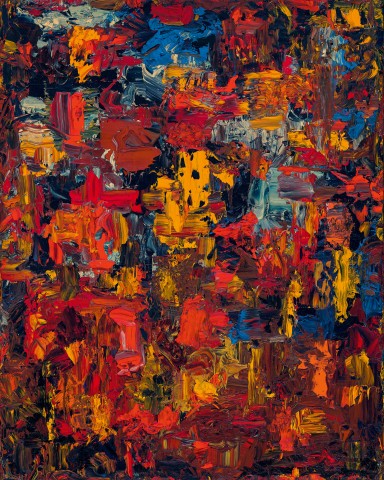PAINTING, 1975
PETER BOOTH
oil on linen
76.0 x 61.0 cm
signed verso: PETER BOOTH
Probably: Pinacotheca, Melbourne
Tolarno Galleries, Melbourne
The National Australia Bank Art Collection, acquired from the above in 1976 (label attached verso)
The Seventies: Australian Paintings and Tapestries from the Collection of National Australia Bank, National Gallery of Victoria, Melbourne, 15 October – 28 November 1982
The Seventies: Australian Paintings and Tapestries from the Collection of National Australia Bank, Geelong Art Gallery, Victoria, 30 April - 29 May 1988
Lindsay, R., The Seventies: Australian Paintings and Tapestries from the Collection of National Australia Bank, The National Bank of Australasia, Melbourne, 1982, pl. 12, p. 25 (illus.)
Hart, D., William Delafield Cook, Craftsman House, Sydney, 1998, p. 119
Untitled, 1975 is perhaps less familiar in character than Booth’s formative abstract paintings and his spectral figuration that began in the late seventies. But there is one element which connects every phase – it is always the expressive and psychological possibilities through the act of painting.
Booth’s late sixties Colourfield paintings are invariably large and usually represented with two or three juxtaposed blocks of colour within a larger expansive colour. Unlike many of his co-exhibitors in The Field exhibition, Booth’s forms are never immaculately edged, and he avoided the flat formality of hard-edge painting as we know it.1 Amongst the Field a stained effect was common – one which avoided mannered surfaces, let alone painterly verve. Booth was never willing to withhold the emotional potential of painting. His vast surfaces were not coolly flat but acknowledge the hand of the artist – each ‘blocks’ edge deliberately avoid any suggestion of taped masking helping to delineate edges and define forms.
This approach reached its sublime eloquence in the so-called ‘doorway’ paintings: vertical rectangular-shaped black canvases and narrowly bordered on three edges with a contrasting colour where black drips and inflections spill onto it. The viscous glossy surfaces with their swathes of controlled painterly grandeur are superb examples of a quiet, inscrutable presence in new abstraction in Australia.2 These are contemplative and meditative works for unhurried viewing.
Untitled, 1975 was made in the wake of the doorway paintings. An unrestrained exuberance of gestural energy has abandoned former subtleties. There can be no ambiguity – these are impassioned paintings rich with impasto, a palette knife forging an overall anxious effect of colour and darkness. Booth is seldom one to talk about personal circumstances or states of mind as catalysts for approaches to making a particular work. Nonetheless in the few paintings of this kind, many include mirror fragments imbedded in the paint itself.3 In 1975, in a mistaken home invasion he was attacked and pushed into a mirror which smashed and he thus incorporated in these works.
Booth enjoys equal respect as an abstractionist and figurative painter. His surreal and apocalyptic images eschew literalism and emerge from the artist’s subconscious. Black has always remained an essential part of his expression which includes, of course, a magnificent body of drawings. While resolved and complete within itself, we can also easily imagine Untitled as a clipped vignette, a detail anticipating something fuller in a nightmare of abstracted forms and people in the paintings which followed.
1. Many artists in The Field exhibition showed a strong predilection for what Clement Greenberg (1909 – 1994) coined Post Painterly Abstraction; a term used as a counterpoint to Abstract Expressionism and its brushed mannerisms and occasional claims to mysticism.
2. One of the finest examples of these is Untitled, 1971, synthetic polymer paint on canvas, collection of the National Gallery of Victoria, Melbourne
3. A complementary work is Painting, 1976, synthetic polymer and metallic paint on mirror and stones on canvas, collection of the National Gallery of Victoria, Melbourne. It is included in Gellatly, K.(ed.), 101 Contemporary Australian Artists, National Gallery of Victoria, Melbourne, 2012, p. 35 (illus.)
DOUG HALL AM
